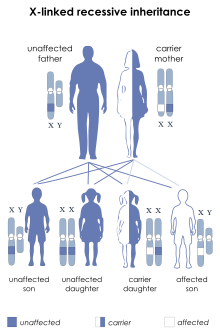| X-linked agammaglobulinemia | |
|---|---|
| Other names | X-linked hypogammaglobulinemia, Bruton type agammaglobulinemia, Bruton syndrome, sex-linked agammaglobulinemia[1]: 83 |
 | |
| The disorder is passed on in an X-linked recessive pattern | |
| Specialty | Immunology |
X-linked agammaglobulinemia (XLA) is a rare genetic disorder discovered in 1952 that affects the body's ability to fight infection. As the form of agammaglobulinemia that is X-linked, it is much more common in males. In people with XLA, the white blood cell formation process does not generate mature B cells,[2] which manifests as a complete or near-complete lack of proteins called gamma globulins, including antibodies, in their bloodstream. B cells are part of the immune system and normally manufacture antibodies (also called immunoglobulins), which defend the body from infections by sustaining a humoral immunity response. Patients with untreated XLA are prone to develop serious and even fatal infections. A mutation occurs at the Bruton's tyrosine kinase (Btk) gene that leads to a severe block in B cell development (at the pre-B cell to immature B cell stage) and a reduced immunoglobulin production in the serum. Btk is particularly responsible for mediating B cell development and maturation through a signaling effect on the B cell receptor BCR. Patients typically present in early childhood with recurrent infections, in particular with extracellular, encapsulated bacteria.[3] XLA is deemed to have a relatively low incidence of disease, with an occurrence rate of approximately 1 in 200,000 live births[4] and a frequency of about 1 in 100,000[5] male newborns. It has no ethnic predisposition. XLA is treated by infusion of human antibody. Treatment with pooled gamma globulin cannot restore a functional population of B cells, but it is sufficient to reduce the severity and number of infections due to the passive immunity granted by the exogenous antibodies.[3]
XLA is caused by a mutation on the X chromosome (Xq21.3-q22) of a single gene identified in 1993 which produces an enzyme known as Bruton's tyrosine kinase, or Btk.[3] XLA was first characterized by Dr. Ogden Bruton in a ground-breaking research paper published in 1952 describing a boy unable to develop immunities to common childhood diseases and infections.[6] It is the first known immune deficiency, and is classified with other inherited (genetic) defects of the immune system, known as primary immunodeficiency disorders. It is also classified as an inborn error of immunity based on it being an immunological disorder caused by a defect in a single gene.[7]
- ^ James, William D.; Berger, Timothy G.; et al. (2006). Andrews' Diseases of the Skin: clinical Dermatology. Saunders Elsevier. ISBN 0-7216-2921-0.
- ^ "X-linked Agammaglobulinemia: Immunodeficiency Disorders: Merck Manual Professional". Retrieved 2008-03-01.
- ^ a b c X-Linked Agammaglobulinemia Patient and Family Handbook for The Primary Immune Diseases. Third Edition. 2001. Published by the Immune Deficiency Foundation
- ^ Chun, Jin-Kyong; Lee, Taek Jin; Song, Jae Woo; Linton, John A; Kim, Dong Soo (2008-02-29). "Analysis of Clinical Presentations of Bruton Disease: A Review of 20 Years of Accumulated Data from Pediatric Patients at Severance Hospital". Yonsei Medical Journal. 49 (1): 28–36. doi:10.3349/ymj.2008.49.1.28. ISSN 0513-5796. PMC 2615253. PMID 18306466.
- ^ Mahmoudi, Massoud (2007). Allergy and Asthma: Practical Diagnosis and Management. McGraw-Hill Professional. ISBN 978-0-07-147173-2.
- ^ Bruton OC (1952). "Agammaglobulinemia". Pediatrics. 9 (6): 722–8. doi:10.1542/peds.9.6.722. PMID 14929630. S2CID 245180200.. Reproduced in Buckley CR (1998). "Agammaglobulinemia, by Col. Ogden C. Bruton, MC, USA, Pediatrics, 1952;9:722-728". Pediatrics. 102 (1 Pt 2): 213–5. doi:10.1542/peds.102.S1.213. PMID 9651432.
- ^ Nishimura A, Uppuluri R, Raj R, Swaminathan VV, Cheng Y, Abu-Arja RF, Fu B, Laberko A, Albert MH, Hauck F, Bucciol G, Bigley V, Elcombe S, Kharya G, Pronk CJ, Wehr C, Neven B, Warnatz K, Meyts I, Morio T, Gennery AR, Kanegane H (November 2023). "An International Survey of Allogeneic Hematopoietic Cell Transplantation for X-Linked Agammaglobulinemia". Journal of Clinical Immunology. 43 (8): 1827–1839. doi:10.1007/s10875-023-01551-2. PMID 37454339.